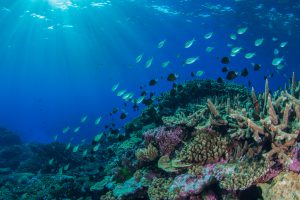Research published in Nature has found that fish respond to warming seas more strongly than they do to bleaching of corals.
Griffith University researchers played a key role in the study — which was led by the University of Tasmania and included researchers from James Cook University – thatanalyseddata on fish, invertebrates and corals that were collected across the Great Barrier Reef and Coral Sea both before and after the 2016 ocean heat wave.
It identified important changes in reef-animal communities that may affect the resilience of coral reefs, potentially reducing the capacity of corals to rebuild after mass bleaching.

Credit: Rick Stuart-Smith
Recent mass coral bleaching on the Great Barrier Reef has devastated large areas of coral, and corals are a key habitat for many types of fish.
“We know that coral reef ecosystems are changing dramatically in response to global warming, but the focus has usually been on the fate of corals, with clear impacts of mass bleaching observable from aerial images,” study leader Rick Stuart-Smith of the University of Tasmania said.
But fish also respond directly to warming waters. The fish that live on the Great Barrier Reef play a crucial role in its ecosystems, the tourism industry and fishing industries.
“There were broad regional changes in fish communities that were consistent all the way from the far northern reefs to the southern reefs,” study co-authorDrChris Brown of Griffith University’s Australian Rivers Institute said.
“Fish are cold-blooded organisms, so there are certain temperatures that suit them best. They don’t like the water to be too hot or too cold.”
One of the groups of fish that responded strongly to the heatwave were herbivorous fish. These fish eat algae, which assists coral recovery following bleaching.
The study found herbivorous fish declined on the northern reefs, most likely because waters became too warm for them. They may have increased slightly at cooler southern reefs.
The team were able to conduct this analysis because of extensive data on corals and fish provided by the Reef Life Survey (RLS) citizen science program.
DrStuart-Smith said the observations suggested that recovery processes would depend on functional changes in reef communities, which in turn depended on how temperatures changed the makeup of fish and invertebrates that lived on the reefs.
“These findings underscore the importance of building the reef’s resilience through local management actions,”DrBrown said.
“Doing so is not only important for the reef’s corals, but also its fish community.”
As well as considering how to conserve and restore corals in areas affected by bleaching,DrStuart-Smith said there also needed to be consideration on how to maintain or build the broader fish communities that provided reef resilience.
“This may mean considering where particular species in these important groups are subject to overlapping pressures such as fishing, warming and habitat loss, to better plan protected areas or manage human pressures like pollution for a warmer future,” he said.
The study was led by researchers from the Institute of Marine and Antarctic Studies (IMAS), University of Tasmania. Australian Rivers Institute, Griffith University and the ARC Centre of Excellence for Coral Reef Studies, James Cook University were partners in this study. Analyses were supported by the Marine Biodiversity Hub, a collaborative partnership supported through the Australian Government’s National Environmental Science Program.
